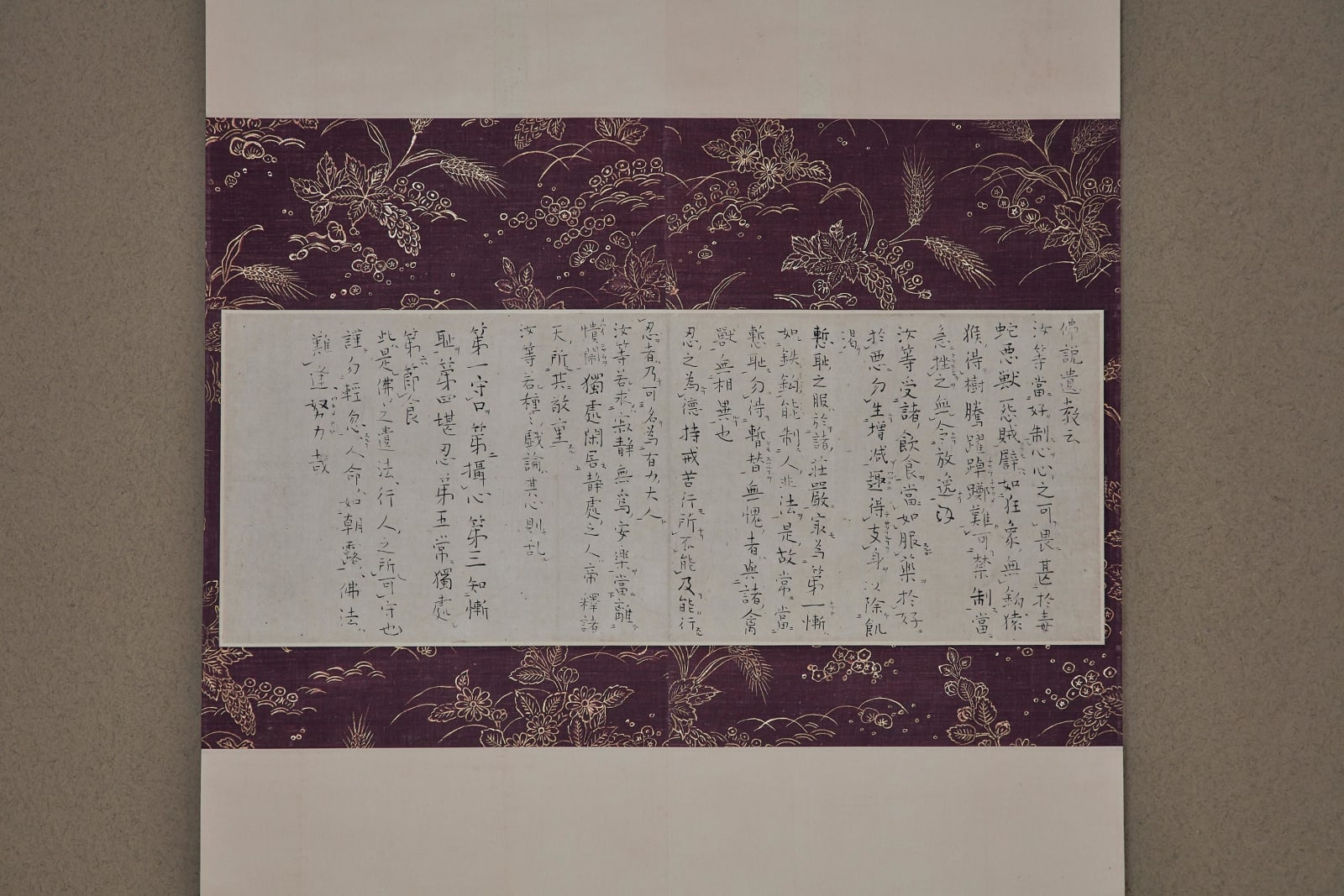Ryōkan (1758–1831)
Extracts from the Sutra of the Deathbed Injunction
Ink on paper, hanging scroll
With box authentication by Yasuda Yukihiko, double boxed
22.8 x 61 cm
103 x 64 cm (overall)
With box authentication by Yasuda Yukihiko, double boxed
22.8 x 61 cm
103 x 64 cm (overall)
Further images
Literature
Ryokan bokuseki taikan. Vol. 6. Tokyo: Chuokoron Bijutsu Shuppan, 1993.
Ryokan wrote in several different calligraphic scripts, from freewheeling kana to lively cursive script and minute regular script, with each manifesting a virtuousness that could only have emerged from his brush. Of particular note is ‘diminutive regular,’ a style that meticulously and steadfastly renders each small stroke to create an exquisite beauty. When Ryokan uses diminutive regular, his careful, pragmatic strokes are devoid of any nervous fragility and they reveal his good-natured character as clearly as works rendered in other scripts. The painter Yasuda Yukihiko greatly admired Ryokan’s writing. He strove to collect and verify calligraphic works by Ryokan and he spoke thus about Ryokan’s regular script: “the regular script he learnt from calligraphy by Jin and Tang masters is frequently reminiscent of Chu Suiliang, but the minute characters bring to mind epigraphs carved on metal and stone in ancient Japan.” Yukihiko praised the simplicity of Ryokan’s writing and the way it resembled a finely-etched engraving, an appraisal that also applies to this work. Yukihiko’s veneration for Ryokan’s calligraphy is also apparent in the characters Yukihuko penned on the accompanying box.
As Ryokan writes at the start of this work, the writing here is taken from the Sutra of the Deathbed Injunction, an account of the dying Buddha’s last words to his disciples. This was translated into Chinese by Kumarajiva, a Buddhist priest active during the Later Qin period. During Emperor Huizong of Song’s reign, Shousui, a Zen (Ch. Chan) priest at Mount Dahong, compiled this sutra together with the Sutra in Forty-Two Chapters and Guishan's Admonitions. He wrote individual commentaries for each and he published the set as the Three Scriptures of the Buddhas and Patriarchs. This work was promulgated widely and it was treasured as an indispensable Buddhist text for novices of Zen Buddhism and other schools.
For this work, Ryokan has selected key points from the source text rather than merely transcribing it as written. Furthermore, the contents become even more concise starting from six lines from the back, with Ryokan summarizing six points in one passage before exhorting the reader in the final three lines to remember the teachings and strive to follow them. Ryokan has also written guiding marks for rendering Chinese into Japanese at the side of the main text, perhaps at the request of the person commissioning the work. These engender a sense of proximity, almost as if Ryokan is speaking directly to the reader, carefully explaining the Buddha’s teachings. These details reveal his profound thoughtfulness and sincere desire to transmit his message directly to the hearts of his readers.
Ryokan (Zen priest, poet; 1758–1831)
Born in Echigo Province (now Niigata Prefecture), Ryokan trained as a monk at Koshoji temple in his home province, and later at Entsuji in Bitchu (now Okayama Prefecture). Leading an itinerant life for many decades, Ryokan counted as a something of an eccentric even for Zen standards, yet his contribution to waka (Japanese-style poetry) and calligraphy remains highly regarded.
As Ryokan writes at the start of this work, the writing here is taken from the Sutra of the Deathbed Injunction, an account of the dying Buddha’s last words to his disciples. This was translated into Chinese by Kumarajiva, a Buddhist priest active during the Later Qin period. During Emperor Huizong of Song’s reign, Shousui, a Zen (Ch. Chan) priest at Mount Dahong, compiled this sutra together with the Sutra in Forty-Two Chapters and Guishan's Admonitions. He wrote individual commentaries for each and he published the set as the Three Scriptures of the Buddhas and Patriarchs. This work was promulgated widely and it was treasured as an indispensable Buddhist text for novices of Zen Buddhism and other schools.
For this work, Ryokan has selected key points from the source text rather than merely transcribing it as written. Furthermore, the contents become even more concise starting from six lines from the back, with Ryokan summarizing six points in one passage before exhorting the reader in the final three lines to remember the teachings and strive to follow them. Ryokan has also written guiding marks for rendering Chinese into Japanese at the side of the main text, perhaps at the request of the person commissioning the work. These engender a sense of proximity, almost as if Ryokan is speaking directly to the reader, carefully explaining the Buddha’s teachings. These details reveal his profound thoughtfulness and sincere desire to transmit his message directly to the hearts of his readers.
Ryokan (Zen priest, poet; 1758–1831)
Born in Echigo Province (now Niigata Prefecture), Ryokan trained as a monk at Koshoji temple in his home province, and later at Entsuji in Bitchu (now Okayama Prefecture). Leading an itinerant life for many decades, Ryokan counted as a something of an eccentric even for Zen standards, yet his contribution to waka (Japanese-style poetry) and calligraphy remains highly regarded.







